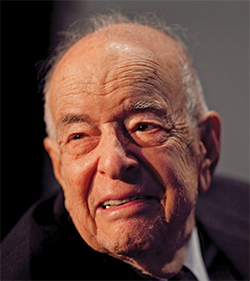Who is Herbert Tabor?
Now 99 years old, Herbert Tabor is a senior investigator at the National Institute of Diabetes and Digestive and Kidney Diseases. From 1971 to 2010, he served as editor-in-chief for the Journal of Biological Chemistry, overseeing its expansion from 1,000 to 4,500 published articles per year and its transition to online publication.
 Herbert Tabor
Herbert Tabor
Over the years, he also has authored 31 articles published in JBC, including nine co-authored with his wife, the late Celia White Tabor.
The JBC/Herbert Tabor Young Investigator Awards were conceived to honor him, said Associate Editor George DeMartino of the University of Texas Southwestern Medical Center. “And there’s probably nothing that would honor him more than having good papers published in JBC.”
Here’s a brief look at Tabor’s life and accomplishments:
| 1905: | The Journal of Biological Chemistry is founded. |
| 1918: | Herbert Tabor is born in New York City. |
| 1937: | Tabor graduates from Harvard College. |
| 1940: | Tabor meets Celia White on a streetcar in Boston. |
| 1941: | Tabor graduates with an M.D. from Harvard Medical School. |
| 1942: | Tabor starts an internship at Yale New Haven Hospital, working concurrently in the lab of John Peters. |
| 1943: | Tabor joins the war effort as medical officer on a Coast Guard cutter escorting Atlantic convoys. |
| 1943: | Tabor is transferred to the National Institutes of Health, joining Sanford Rosenthal’s team to study treatment for burns and traumatic shock. |
| 1943: | Tabor’s first article is published in JBC: Tabor and Hastings, “The ionization constant of secondary magnesium phosphate.” |
| 1946: | Herb Tabor and Celia White marry. |
| 1949: | The Tabors move into commissioned officer housing on the NIH campus, where they raise their children and where Herb Tabor still lives today. |
| 1952: | Celia White Tabor joins the Rosenthal lab, starting the Tabors’ shared research. |
| 1961: | Tabor joins the editorial board of JBC. |
| 1971: | Tabor becomes editor-in-chief of JBC. |
| 1975: | The Tabors’ first joint article is published in JBC: H. Tabor and C.W. Tabor, “Isolation, characterization and turnover of glutathionylspermidine from Escherichia coli.” |
| 1995: | JBC becomes the first scientific journal to be published online. |
| 2010: | Tabor steps down as editor-in-chief, becomes co-editor and continues his bench research. |
| 2011: | JBC Editor-in-Chief Marty Fedor announces establishment of the JBC/Herbert Tabor Young Investigator Awards to be presented by journal associate editors to presenters at specialized scientific meetings. |
| 2013: | Published in JBC 70 years after Tabor’s first JBC article: Chattopadhyay and Tabor, “Polyamines are critical for the induction of the glutamate decarboxylase dependent acid resistance system in E. coli.” |
| 2017: | JBC Editor-in-Chief Lila Gierasch announces the Tabor awards will honor work on top-notch papers published by JBC. |
Enjoy reading ASBMB Today?
Become a member to receive the print edition four times a year and the digital edition monthly.
Learn moreGet the latest from ASBMB Today
Enter your email address, and we’ll send you a weekly email with recent articles, interviews and more.
Latest in People
People highlights or most popular articles

In memoriam: Michael J. Chamberlin
He discovered RNA polymerase and was an ASBMB member for nearly 60 years.

Building the blueprint to block HIV
Wesley Sundquist will present his work on the HIV capsid and revolutionary drug, Lenacapavir, at the ASBMB Annual Meeting, March 7–10, in Maryland.

In memoriam: Alan G. Goodridge
He made pioneering discoveries on lipid metabolism and was an ASBMB member since 1971.

Alrubaye wins research and teaching awards
He was honored at the NACTA 2025 conference for the Educator Award and at the U of A State and National Awards reception for the Faculty Gold Medal.

Designing life’s building blocks with AI
Tanja Kortemme, a professor at the University of California, San Francisco, will discuss her research using computational biology to engineer proteins at the 2026 ASBMB Annual Meeting.

Jordahl named Gilliam Fellow
He will receive three years of funding to support his thesis research.

